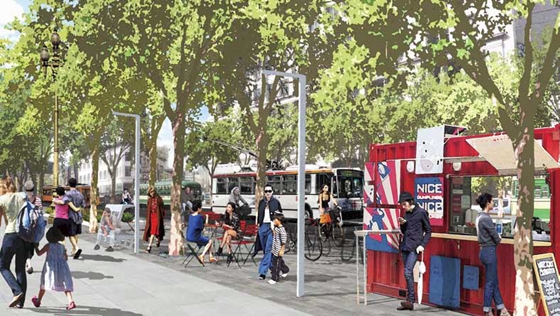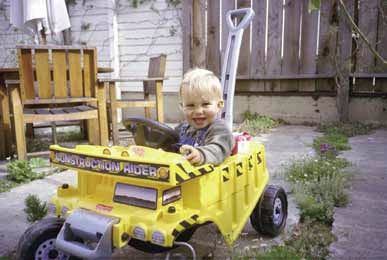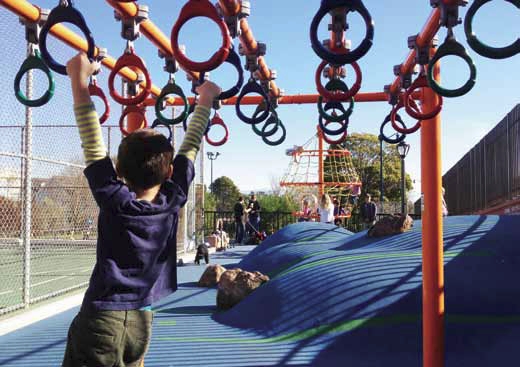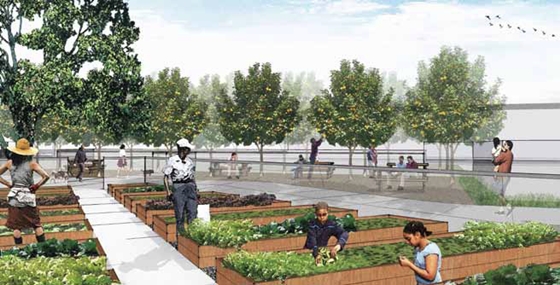"디자인에서 진정성은 항상 중요해"
케빈 콘거와의 대담
마켓스트릿 스트리트라이프 구역 ⓒCMG Landscape Architecture
개인적 배경
Q. 이력서에 나와 있지 않은 내용으로 자신을 표현한다면? 당신의 설계 실무를 좌우하는 원칙들은 어떤 것입니까?
A. 저의 디자인은 개념적이면서도, 동시에 매우 실용주의적입니다. 실용적인 측면이란 프로젝트가 처한 다양한 조건에 대한 매우 직설적인 응답이라 할 수 있는데요, 그 조건이란 것은 용도, 대지의 상태, 발주자의 요구, 예산, 법규 그 무엇이든 상관이 없습니다. 개념적 측면이란 오로지 도시적 상황이나, 생태학, 사람들의 행태, 혹은 실존적 상황이라든가 등등 그 밖의 것들에 대한 논리적 가설과 의견에서 출발합니다. 디자인이란 결코 어떤 사물, 사실에 대한 묘사나 비유가 될 수 없습니다. 제가 로즈아일랜드디자인스쿨(RISD)에 다닐 때, 어떤 훌륭한 선생님께서 디자인에 있어서의 의미(meaning)와 진실성(honesty)에 대해서 정확하게 구분을 해주셨습니다. 제가 보기에, 진실성은 항시 중요하고 핵심적인 것입니다. 반면, 의미란 있을 때도 있고, 없을 때도 있는 가변적인 요소일 뿐입니다.
Q. 그간의 작업을 되돌아볼 때, 하나의 이정표가 될만한, 획기적 전환점이었다고 평가할만한 프로젝트를 꼽는다면?
A. 너무 많죠! 저는 과분하게도 멘토가 될 만한 분들과 함께 일할 행운을 얻었고, 그들로부터 많은 것을 배웠습니다. 마샤 슈왈츠나 하그리브스의 회사에서요. 우선, 그들 회사에서의 경험이 기반이 되었습니다.
다음으로 지금까지 CMG가 해 온 매우 작은 프로젝트들이 있는데, 이것들은 복잡다단한 프로젝트의 현실적 조건에서 자유롭게 갖가지 아이디어들을 시험해볼 수 있는 기회였습니다. 크랙가든이나 팬핸들 밴드쉘 같은 것이 좋은 예고요. 또한 커뮤니티에 중점을 두고 있는 공적공간에 대한 작업이 저희의 핵심 사명이었습니다. 민트플라자나 더보스 파크, 웨스트오클랜드의 도시농업공원과 같은 프로젝트들은 CMG의 근간을 형성해 왔습니다. 우리의 컨셉을 더 큰 규모의 도시적 맥락에 적용하게 되는 프로젝트들을 통해 대중의 신임을 얻었고, 커뮤니티에 중요한 기여를 할 수 있는 기회를 얻었습니다. 예를 들어 샌프란시스코만 한가운데의 버려진 해군기지를 재개발하는 트레져 아일랜드의 경우라든가, 샌프란시스코의 중심가로인 마켓스트리트(market street)를 개조하는 거대하고 복잡한 프로젝트가 그것입니다.
Q. 조경가로서, 당신에게 영향을 미친 사람이 있다면 누구인가요?
A. 로버트 로이스톤(Robert Royston)입니다. 에크보와 함께 전후 미국 조경에서 선도적 역할을 한 인물로서 작업과 회사운영 방식에 대해 존경합니다. 그의 작업은 다양성이 무척 높고, 항상 해당 지역에 기초를 두고 있습니다. 디자인은 진보적이며, 표현력도 풍부합니다. 또한 시대감각에 있어 떨어지지 않습니다. 한편, 로렌스 할프린(Lawrence Halprin)의 초기 작품 중 몇 가지, 포틀랜드의 켈러 분수공원(Keller Fountain Park) 같은 사례는 매우 간명(reductive)하고도 원초(elemental)적인 맛이 있어, 강한 공간적 경험을 주지요. 로버트 라이먼(Robert Ryman)과 같은 미니멀리스트 아티스트나, 로버트 스밋슨(Robert Smithson), 마이클 하이저(Michael Heizer), 고든 마타-클락(Gordon Matta-Clark)같은 개입주의자(interventionist)들 또한 저에게 영향을 준 사람들입니다.

프로젝트
Q. 예르바부에나 스트리트라이프 계획(The Yerba Buena Street Life Plan)에서의 경험을 말씀해주시겠습니까? 작은 골목과 뒷길들을 개선하는데 있어서의 난관은 무엇인가요?
스트리트라이프 계획은 10년간의 장기계획이고, 36개의 하위 프로젝트를 포함하고 있습니다. 이런 작은 움직임들이 중요한 이유는 무엇인가요?
A. 스트리트라이프 계획은 커뮤니티에 기반한 주민 발의 디자인입니다. 다시 말해, 주민들의 지역조직(여기서는 The Yerba Buena Community Benefits District, YBCBD가 해당)이 주축이 되어 시작되고, 재정이 마련되는 사업으로서, 정부 기관이 벌이는 사업과 다르지요. YBCBD는 당연히 어떠한 사법권도 가지고 있지 못합니다. 단지, 보도를 청소한다거나 그래피티를 지우거나 동네 페스티벌이나 이벤트들을 준비하고 그 지역의 권리를 대변할 일이 있을 때 나서는 정도입니다. 이런 상황에서 스트리트라이프 계획은 지역 공간에 대한, 보다 장기적인 향상이라는 주민들의 관심을 나타내고 있습니다. 그리고 그 중 가장 중요한 요소는 길과 보도입니다.
막상 일을 시작해보니, 주민들이 공적공간에 대해 실제로 원하는 바람은 대개 매우 작은 규모임을 깨달았습니다. 길거리에 쓰레기가 없었으면 좋겠다, 좀 더 좋은 가로수가 있었으면 좋겠다, 좋은 가로등, 보다 안전한 횡단보도, 앉을만한 장소, 자전거를 묶어둘 장소에 이르기까지 세세한 내용이었죠. 저희가 맡은 임무는 이러한 작은 요청들 이면에 존재하는 보다 근본적인 가치를 파악하는 일이었습니다. 또한 이 가치들을 연장하여, 보다 큰 규모의 장기적인 생각들을 포함하는 비전과 원칙들을 수립해야 했습니다. 물론, 작은 요소들도 다 중요하고, 하나하나가 높은 수준으로 구현될 수 있도록 노력해야 합니다. 결과적으로 계획서에서는 주물로 만든 주문제작 자전거 거치대나 벤치와 같은 작은 아이템들부터, 한산한 뒷골목 도로를 광장으로 만드는 중규모의 프로젝트, 그리고 모스콘 컨벤션센터 주위 지역에 대한 대규모 사업까지 다양한 스케일을 다루고 있습니다. 자전거 거치대나 벤치는 현재 설치 중에 있고요. 모스콘 컨벤션센터 주변부 계획은 YBCBD가 제어할 수 있는 범위를 벗어나기 때문에, 시청에서 관할하는 모스콘 컨벤션센터 확장사업의 일환으로 진행되고 있습니다. 스트리트라이프 계획과 같은 프로젝트가 가치 있는 이유는 지역주민들이 종합적인 공간 향상에 대한 목록을 보유하게 되고, 동네의 개선 원칙들에 대해서 구체적이고 분명한 목소리를 낼 수 있기 때문입니다.
반면, 어려운 점이라 하면 YBCBD 자체가 작고 힘없는 단체에 불과하기 때문에, 이러한 사업을 추진할 자금이나 권한이 부족하다는 점이죠. 그래서 이러한 계획서는 궁극적으로는 시의 정책에 영향을 미칠 수 있는 도구로써 사용되는데, 현재까지는 상당한 성과를 보이고 있습니다.
Q. 마켓스트리트는 샌프란시스코의 두 가지 격자형 도로체계가 만나는 지점에 뻗어있습니다. 마켓스트리트 개선계획에서 의도한 주요 목표는 무엇입니까?
A. 우리는 마켓스트리트가 샌프란시스코에서 새로운 최상급 공적공간이 되어, 사람들이 찾는 장소로 만들기를 원했습니다. ‘샌프란시스코라는 도시를 가장 잘 느끼려면 어디로 갈까?’라는 고민을 할 때 떠오르는 장소가 되도록 말입니다. 그런데 이 수준에 도달하기 위해서는 혁신적인 변화가 필요합니다. 현재 마켓스트리트에는 많은 사람들이 오고 갑니다. 그러나 사람들은 대부분 버스나 전철에서 내리자마자 각자의 목적지를 향해 흩어질 뿐입니다.
마켓스트리트의 공간적인 질적 수준은 매우 떨어집니다.
공간의 변화가 단조롭고, 앉아서 쉴만한 장소나 멋지게 조성되어 그저 서성대도 되는 좋은 장소도 없습니다. 그러기에 사람들은 마켓스트리트를 이용하긴 하지만, 곧바로 흩어져버리게 됩니다. 컨설팅팀과 샌프란시스코시는 공동으로, 이러한 상황을 극적으로 개선하여, 수준 높은 공적공간을 조성하는 동시에 다양한 대중교통체계를 효과적으로 향상시킬 수 있는 대안을 고안해냈습니다. 그 결과 지역주민들로부터 많은 긍정적 지지를 받고 있고, 현재 환경영향평가가 진행 중인데, 모든 개선계획이 향후 5년 이내에 실행될 것입니다.
샌프란시스코에서 공공공간 사업 대부분이 상당한 시간을 필요로 합니다.
Q. 2009년 ASLA상을 수상한 크랙가든은 알고 보면 꽤 오래된 프로젝트인데, 최근 활발하게 논의되고 있는 도시에 대한 전략적 개입, 예를 들어 Depave운동과 같은 노력의 선구자격인 작업이었다고 보입니다. 어디서 아이디어를 얻은 것입니까?
A. 그 곳은 사실 저희 집 뒷마당이었습니다. 당시에 콘크리트 포장면이었던 곳을 뜯어내고 정원을 조성할 돈이 없었습니다. 그래서 있는 그대로의 상태를 디자인을 위한 개념적 기초로 이용하기로 마음먹었던 것입니다. 어떤 새로운 재료의 층을 투입해서 덮는 것보다, 있는 것을 없애기만 하면서 개입하는 전략이 훨씬 더 흥미롭다고 생각했습니다. 그래서 간단하게 콘크리트 슬라브를 전동드릴로 부수면서, 하부의 원토양이 드러나서 식물을 키우고 물을 흡수하는 본래의 기능을 다할 수 있도록 했습니다. 막상 디자인 차원에서 고민했던 것은 ‘어떤 패턴으로 포장면을 제거하는가’ 하는 문제였습니다. 두 명의 친구가 도와준 덕분에 주말 동안 완성할 수 있었던 공사입니다.
Q. ‘공유하는 거리(Shared Public Way)’는 무엇이고, 기술적 난제와 정치적 난관은 무엇인지 설명해주십시오.
A. 공유하는 거리라는 것은 거리의 한 형태로서, 보행자를 최우선에 두고 자동차나 자전거를 포함한 나머지 모든 교통수단을 수용하는 방식입니다. 보행자는 보도뿐만 아니라, 도로 한가운데로 자유롭게 다닐 수 있다는 것이 전제입니다.
차량 속도를 저속으로 통제하기 때문에 통행량이 적은 도로에서만 시행될 수 있습니다. 기술적인 문제라고 하면, 운전자가 보행자에게 충분한 주의를 기울일 수 있을 정도로 지시하는 일입니다. 또한 시각·청각 장애인들이 이러한 가로 구조를 이해하고, 보차혼용구역을 이용하지 않도록 하는 것이 과제입니다.

경영
Q. CMG의 사장 겸 최고경영자로서 어느 정도로 바쁘신지요? 여전히 프로젝트의 디자인 과정에 참여하고 있으신가요?
A. 정말 무척 바쁩니다. 하지만 과거에도 항상 바쁘긴 마찬가지였죠. 중요한 것은 제가 회사 구성원 중 누구보다도 더 바쁘지는 않다는 점입니다.
예, 저는 여전히 디자인 과정에 참여하고 있습니다. 그러나 참여라고 할 때 집중하는 부분은 전략적인 순간에 한합니다. 프로젝트의 컨셉을 수립하고, 현실적인 요구사항을 이해하며, 발주자와 대화하고, 지역주민들과 소통하는 과정, 마지막으로 기술적인 디테일이나 시공 현장을 감독하는 일이죠. 이렇게 말하고 보니 프로젝트의 거의 모든 과정이 망라된 듯 한데요. 제가 거의 관여하지 않는 부분이지만 매우 중요한 일이란, 형태(form)를 결정하기 위한 스터디 과정, 3D 모델링 과정, 그리고 보고서 작성 과정입니다. 우리 회사의 프로젝트는 형태보다는 아이디어에 기반하고 있습니다. 따라서 저의 역할은 각 프로젝트에서 아이디어들을 보다 명료하게 정의하는 것을 도와주고, 최종 성과물이 높은 품질을 갖도록 점검하는 일입니다.
Q. CMG의 프로젝트에서는 독특한 예술적 아이디어를 읽을 수 있습니다. 그러나 더욱 강렬하게 느껴지는 것은 사회적, 도시적 문제들을 확연하게 제기하는 것입니다. 당신의 조경이 말하는 커뮤니티 만들기란 무엇입니까?
A. 커뮤니티란 개인들로 구성된 두 가지 집단으로 볼 수 있는데요. 첫째, 공동의 가치를 공유하고 있거나, 둘째, 공유된 공간을 통해 서로 교류하는 경우입니다. 혹은 두 가지가 한꺼번에 일어나기도 하고요. 저희 회사가 생각하는 커뮤니티 만들기란 모든 개인들에 대한 배려의 수준을 끌어올리는 것이라 부를 수 있습니다.
저희가 하고 있는 일은 어쩌면 도시에서 특히 샌프란시스코 주변을 대상으로, 도시와 환경 문제를 다루는 하나의 큰 프로젝트라고 볼 수 있습니다. 각각의 구체적인 프로젝트들은 단지 이 거대한 임무의 한 부분일 뿐이죠. 작게는 무료봉사 프로젝트, 주민들이 주축이 된 커뮤니티 발의, 위원회 자문활동, 시민운동을 돕기 위한 강연 활동이 있습니다.
이 모든 작은 중요한 활동들이 모여서 큰 흐름을 이룹니다.
Q. CMG에서 말하는 엘 카미노(El Camino) 사고방식이란 무엇입니까?
A. 실용주의가 사뭇 자극적인 아이디어와 합쳐지고, 그 결과 어떤 상투성을 뛰어넘는 작업이 도출되는 과정을 뜻합니다(엘 카미노는 쉐보레의 단종된 차량 모델로, 쿠페형 자가용과 픽업트럭을 합쳐놓은 형태이다. 기이하면서도 동시에 실용적인 느낌을 주는 사례를 표현하는 말로 쓰인다 _ 역주.)
Q. 자체적으로 시작하는 프로젝트들에 대해 말씀해 주시겠습니까? 어떤 이유로, 어떻게 시작되며, 즐거운 점은 무엇인지요?
A. 우리에겐 무척 멋진 아이디어로 보이지만, 아무도 하려 하지 않는 일들이죠. 때로는 어떤 운동의 책임감있는 조력자가 되기 위해서이기도 하고, 긍정적인 임팩트를 주기 위해서입니다. 때론 그저 무엇을 만드는 것이 즐겁고, 창의적인 과정 자체를 즐기기 위해서입니다. 우리는 이런 잠재적 프로젝트들을 많이 가지고 있습니다.
디자인 철학
Q. 최근에 작업하신 ‘Adapt, Transform, Reuse’ 전시에 대해서 궁금합니다. 도시에서 오래된 것과 새로운 것이 공존해야 하는 이유는 무엇입니까?
A. 이번 전시는 샌프란시스코 헤리티지재단과 CMG와의 공동작업 입니다. 우리가 어떻게 해야 역사적 유물로서의 건물과 경관의 디자인을 이해하고, 가치를 평가하며, 다루어야 하는지에 대한 조사입니다.
이러한 일은 광범위한 미술유산에 대한 보존 활동의 연장선상에 있는데, 나폴레옹이 루브르를 역사상 최초의 대중적 미술관으로 만든 때부터 이어져왔다고 할 수 있습니다. 예술적 보화에 대한 보존을 통해 시민에게 혜택을 준다는 발상은 단지 회화나 조각뿐만 아니라 건물과 조경 공간에도 확장되어 왔습니다. 최근에는 특정한 사건이 벌어졌던 장소에 대한 가치까지도 문화적인 기억으로 확대되었죠. 미술품의 보존 노력은 건축구조물 뿐만 아니라 동적이며 살아있는 대상인 경관, 혹은 무형의 문화적 아이덴티티를 가진 장소에까지 펼쳐지고 있습니다.
Q. 캘리포니아 버클리캠퍼스에서 개최된 Xtreme LA 이벤트에 팀 리더로 참여하셨는데, 3일간의 일정 중 느낀 소감을 요약한다면? 전지구적인 기후변화와 해수면 상승의 문제에 대한 디자인을 다룬 것으로 알고 있습니다.
A. 버클리에서의 익스트림 조경 이벤트는 정말 환상적이었습니다. 크리스티나 힐 교수가 행사를 주관했는데, 그녀는 무척이나 똑똑하고 재미난 분이죠. 하그리브스 어소시에이츠(Hargreaves Associates)의 브라이언 젠섹과 제가 공동 팀 리더였습니다. 미국 각지에서 모인 12명의 젊은 디자이너들과, 12명의 UC버클리 학생들이 집중적으로 역량을 펼쳤습니다. 행사는 랜드스케이프폼 조경시설물 제작사과 조경재단에서 후원 받았습니다. 역량 있고 지적인 젊은 디자이너들간의 공동작업에서 생성된 에너지는 정말 놀라운 것이었습니다. 제한된 시간과 여건에도 불구하고 이 젊은이들은 극히 복잡한 문제들에 대해서 정면으로 맞서, 경관의 중요성을 설득력 있게 표현해내었고, 이러한 문제들을 극복하는 데 왜 조경이 큰 역할을 하는지를 효과적으로 보여주었습니다. 저는 이 행사를 통해 무척이나 흥분되고 고양되었습니다. 그리고 해수면 상승이라는 피할 수 없는 미래에 대한 해결책은 디자인에 있다고 확신합니다.
Q. 캘리포니아 예술대학의 도시설계 및 조경 석사과정과 CMG와의 파트너십에서 회사의 역할은 무엇입니까?
A. 캘리포니아 예술대학은 이 지역에서 무척 중요한 교육기관인데요. CMG는 여기서 도시설계-조경 과정을 개발하는데 도움을 주고 있습니다. 특히 경관과 도시문제의 관계에 대해 중점을 두고 있습니다.
Q. 샌프란시스코라는 도시와 경관에 있어서 독특한 점은 무엇이라 할 수 있습니까?
A. 모든 도시는 독특하고도 좀 이상하기 마련입니다. 하지만 저는 샌프란시스코보다 더 별난 도시를 상상할 수 없습니다. 여기서는 민주적인 공적공간에 대한 아이디어가 무척 견고하게 자리 잡고 있습니다. 그 누구도 아닌 바로 시민들 스스로가 공적 영역에 대해 책임이 있다는 것이고, 거기에 정책이나 시의 결정에 대해 권한을 행사할 수 있다는 인식입니다. 그래서 샌프란시스코 사람들은 대체로 거대하고 급작스런 변화에 대해 비판적입니다. 좋건 나쁘건 샌프란시스코에서의 모든 변화는 점진적이고, 작은 규모의 점증이 모인 결과입니다. 샌프란시스코는 무척 독특한 지형에 기반하고 있지요. 작은 반도는 태평양과 샌프란시스코만에 둘러싸여있고 도시에는 작은 언덕들이 곳곳에 솟아 있는데, 이런 물리적 환경은 미기후와 인간의 행동 패턴에 큰 영향을 미칩니다. 재련되지 않은 거친 자연의 아름다움이, 그것이 바다든, 만이든, 산이든, 도시 구석구석에 배어있습니다. 제가 보기에 샌프란시스코에는 아직 손대지 못한 많은 잠재력이 있습니다. 특히 수변을 중심으로 낡은 산업유산 지역에요. 그래서 멋진 미래가 있는 곳이죠.

웨스트 오클랜드 도시농업공원 ⓒCMG Landscape Architecture
Kevin Conger
Personal
Q. How would you describe yourself as a designer, in a way that is not evident by your resume alone? What are some of the guiding principles of your landscape architecture practice?
A. My designs are pragmatic and conceptual at the same time. The pragmatism is usually a result of responding to project conditions in a very direct way, whether itis programming, site conditions, client needs, budget, codes, etc. The conceptualization comes solely from within, usually having to do with some thesis about urbanism or ecology or human behavior or existentialism or whatever. The designs are never narratives or metaphors about other things. When I was in school at RISD I had a great instructor who made clear the difference between meaning and honesty in design, and for me honesty is essential, while meaning is fluid.
Q. Which projects would you consider milestones or turning points in your career?
A. So many! I had the privilege to work with great mentors where I learned a lot, both with Martha Schwartz Inc and with Hargreaves Associates.
Projects with those firms are foundational. CMG has completed a few tiny projects, which are very useful as “sketches” where we can test ideas without complicated project conditions. The Crack Garden and the Panhandle Bandshell are good examples. Our community based work with public realm projects is so essential to our core mission: Mint Plaza, Duboce Park, City Slicker Farm Park in West Oakland, to name a few, and I would describe these projects as a steady and continuous trajectory of the practice. The larger projects where we could apply our concepts on a broader scale have been important for us - Treasure Island, which is the redevelopment of a navy base in the middle of San Francisco Bay, and the redesign of Market Street in San Francisco – these kinds of bigger, complex projects have given us solid credentials and have significant positive impact on our community.
Q. As a landscape architect, who are some of your influences?
A. I really admire some aspects of Robert Royston’s work and practice. The projects are diverse and grounded locally. The designs are progressive and expressive…very contemporary.
Some of Halprin’s early works, like Keller Fountain Park in Portland, are so reductive and elemental, they are very powerful as experiences. Minimalist artists like Robert Ryman, and interventionist sculptors like Smithson, Heizer, and Gordon Matta-Clark.
Projects
Q. Could you tell us about your experience with Yerba Buena Street Life Plan? What are the challenges to improve alleys and small streets? It is a long-term, 10-year plan that has about 36 projects. Why are a lot of small moves important?
A. The Yerba Buena Street Life Plan is a community design initiative, meaning that it was initiated and funded by a community organization (the Yerba Buena Community Benefits District – or YBCBD) rather than a government agency. The YBCBD doesn’t really have any jurisdiction; they basically do sidewalk cleaning, graffiti removal, organize community festivals and events, and try to represent the community’s interests. The Street Life Plan represents the community’s interest in long term improvements to the public realm, which consists primarily of streets and sidewalks.
It turns out that a lot of the public realm improvements that people want are pretty small scale: less litter, nice trees, good street lights, safe cross walks, a place to sit, a place to lock their bike, etc. Our job is to understand the values that underlie the desires for these improvements, and to extrapolate these values into principles and a vision that includes a larger scale of thinking over a longer time frame. At the same time, the little things are very important, so we must realize these small improvement projects too, and do so with a high level of quality. So the plan includes very small scale projects like custom cast iron bike racks and benches that are now being installed all over the district, some medium scaled projects like converting underused alleys into plazas, and larger projects like improvements around the Moscone Convention Center, which is beyond the capacity of the YBCBD, but is being implemented by the City as part of the current convention center expansion project. What is valuable about a project like the Yerba Buena Street Life Plan is that it gives the community a clear voice with an articulate set of principles and an explicit list of improvement projects.
What is challenging is that the YBCBD is only a small community organization and does not have the funding or authority to implement these improvements, so the Plan becomes largely a tool to affect policy within the City, which so far has been very successful.
Q. Market Street is an interesting major thoroughfare where the two grids meet each other. What are the key issues and what would you like to achieve here?
A. We want to make Market Street the premier public space destination in San Francisco. When you are in San Francisco and thinking about where to go experience the City, we want you to think of Market Street. In order for this to be successful the public realm needs to change drastically. The street has a very high volume of people, but primarily they are getting on or off transit or just walking down the street. The quality of the street is pretty poor, the variety of spaces along the street is low, and there are not enough people lingering on the street because there is no place to sit or hang out in a high quality environment. The team of consultants and City agencies has come up with a design that greatly improves the public realm while improving all modes of transit. We have had a lot of community input and very positive support overall. Environmental review is beginning now, and improvements should be underway within five years. Public realm work often moves pretty slowly here.
Q. Crack Garden is actually an older project and really a precursor to the now fashionable tactical intervention such as Depave. How did you come up with the idea?
A. That was my back yard. We had no money to remove and rebuild the garden, so I decided to exploit the existing conditions as the conceptual basis for the design. I thought it was more interesting for the intervention to be mainly removal of existing elements rather than layering on new materials and elements, so I decided to simply remove some concrete and let the soil do its thing (with the help of some plants and water). The only real design question then became where to remove concrete, what pattern, etc. We built it in a single weekend with a couple of friends.
Q. Could you explain “Shared Public Way” and the technical challenges and politics involved with that?
A. A Shared Public Way is a street that prioritizes pedestrians over cars and other vehicles, including bikes. Cars can drive on it, but pedestrians can walk down the middle of the street and are not limited to only the sides.
The main criteria are that the street has a very low volume of vehicle traffic so that traffic can be slowed down. The technical challenges are mostly about giving signals to the drivers to watch out for pedestrians, and giving signals to pedestrians who are visually or hearing impaired so that they know how to navigate thru a vehicle free path area if they do not want to negotiate the vehicle way.
Practice
Q. You are president & CEO of CMG. How busy are you?
Are you still involved in the design process of projects?
A. I’m very busy, but I always have been, and I don’t feel that I am any busier than anybody else at CMG. I am still very involved in the design process, but that involvement is focused on strategic moments in the process: conceptualizing a project, understanding the practical requirements, client interaction and community engagement, and I love technical detailing and construction.
That may sound like most of the project, but where I’m less involved and where so much important work is done is doing formal studies, 3d modeling, and document production. Our work is driven more by ideas than form, so I feel like my role is helping to clarify the ideas and checking in to make sure they are developed with integrity.
Q. Whenever I look at CMG’s projects, I can sense both very original artistic ideas and even stronger social and urbanistic agendas. How do you define community building in landscape architecture?
A. Community is a group of individuals either sharing common values or interacting in a shared living environment, or both. Community building for us means elevating the level of consideration for all of the individuals.
I think about our work as one big project, which is dealing with urbanism and environment, mostly in cities, largely in San Francisco for now. All of our specific projects are simply components of this larger project and mission. The small projects include everything from commissions to pro bono projects to community initiatives to volunteering on committees and lecturing to activism. It all is important and it all adds up.
Q. What is “El Camino Thinking”?
A. When pragmatism meets a provocative idea and the result is something eccentric.
Q. Could you tell us about the “self-initiated” projects?
Why you do them, how they start, and why you enjoy them?
A. Most of our self initiated projects are things that to us seem like a really good idea, but nobody else is going to do it. Some of our self initiated projects are related to being responsible stewards and making a positive impact, while others are related to our desire to make things and our love of the creative process. We have a long list of projects that are underway or we would like to get underway. We just stay busy at it.
Philosophy
Q. Could you tell us about the Adapt/Transform/Reuse exhibition? What’s the importance of the juxtaposition of old and new in cities?
A. The exhibition, co-presented by San Francisco Heritage and CMG Landscape Architecture, is an investigation of how we perceive, value, and treat historic buildings and designed landscapes.
This effort is rooted in fine arts preservation that some say began when Napoleon 1 established the first truly public art museum, the Louvre. The notion of preservation of treasures for civic benefit took hold and expanded from painting and sculpture to buildings, to landscapes and now the locations of varied events valued as sites of cultural memory. The practices applied to art conservation have been carried over to the preservation of structures, then dynamic, living landscapes and now immaterial cultural identity.
Q. You participated in the recent Xtreme LA event at Berkeley as a team leader. Could explain what you have observed through the three days of events? What is your opinion on designing to address global climate change and sea level rise?
A. The Xtreme LA event at UC Berkeley was fantastic. Kristina Hill was the faculty leading the event and she is so smart and fun. Brian Jencek from Hargreaves Associates and I were co-leaders. We had about a dozen talented young professionals from all around the country; joined by about a dozen UC Berkeley students.
The event was sponsored by Landscape Forms and the Landscape Architecture Foundation.
What was so amazing was the power of collaboration between talented and intelligent young designers. With very little time and limited resources these designers tackled an extremely complicated issue and were able to quickly articulate the importance of landscape, and illustrate how design can be the driver for solutions. I was inspired and motivated by the event, and I am 100% confident that design is the lens through which a positive future with sea level rise will be discovered.
Q. What is the role of CMG in the partnership with Master of Architecture in Urban Design and Landscape program at California College of the Arts?
A. CMG is assisting CCA’s development of the program to support this strong local institution, and one that has a shared interest in particular investigations in landscape and urbanism.
Q. What do you think of the unique urbanism and landscape of San Francisco?
A. Every city is unique and weird, for sure, but sometimes I just can’t imagine a place that is more quirky than San Francisco. I think that the idea of democratic public space is really important here; we the people are in charge of our public realm and have control over the policies and decisions that affect it. We are pretty resistant to big change for many reasons, so change of ten comes to San Francisco in bite sized chunks, for better or worse. We have a very unique geography: a small peninsula surrounded by water, and a lot of hills, which has a dramatic affect on micro climate and human patterns. The proximity to raw natural beauty, be it the ocean or the Bay or the mountains, is very pervasive. I think there is so much untapped potential in San Francisco’s landscape, especially along the aging post industrial waterfront, that its future is very exciting.
기획특집·연재기사
- · "안정적 공원운영? 민관파트너십 통한 예산확보로"
- · 주목할만한 조경가 12인_벤자민 돈스키
- · "정원디자인, 시간의 흐름을 따르는 연주"
- · 주목할만한 조경가 12인_피엣 우돌프
- · 주목할만한 조경가 12인_케빈 콘거
- · "옴스테드 디자인철학, 여전히 유효하다"
- · 주목할만한 조경가 12인_비톨드 립친스키
- · "건물을 넘어, 도시 규모로 확대되는 버티컬 가든"
- · 주목할만한 조경가 12인_패트릭 블랑
- · "걷기좋은 도시는 국가를 부유하게 만든다"
- · 주목할만한 조경가 12인_제프 스펙
- · 조경가 '키스 바우어스'와의 대담
- · 주목할만한 조경가 12인_키스 바우어스

























